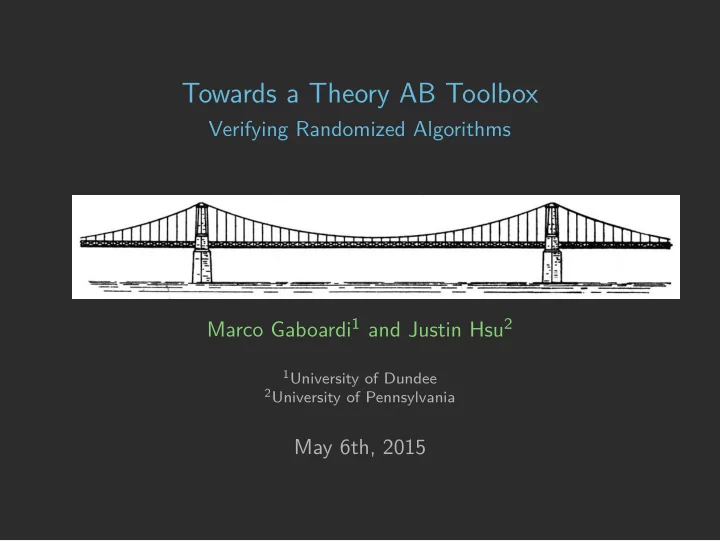

Towards a Theory AB Toolbox Verifying Randomized Algorithms Marco Gaboardi 1 and Justin Hsu 2 1 University of Dundee 2 University of Pennsylvania May 6th, 2015
A story Alice wants to protect privacy
A story Alice wants to protect privacy
Complex code
Complex proofs
Current practice Paper proofs ◮ Produced by humans ◮ Major steps included ◮ Minor steps skipped “Morally correct” ◮ Complex proofs checked by humans ◮ Sometimes bugs
Challenges in formalizing proofs Complex properties ◮ Single run/multiple runs/??? ◮ Quantitative: measure how performance scales with input
Challenges in formalizing proofs Complex properties ◮ Single run/multiple runs/??? ◮ Quantitative: measure how performance scales with input Diverse proofs ◮ Variety of tools and proof structures, non-local reasoning ◮ Proof about a single program can be research contribution
Challenges in formalizing proofs Complex properties ◮ Single run/multiple runs/??? ◮ Quantitative: measure how performance scales with input Diverse proofs ◮ Variety of tools and proof structures, non-local reasoning ◮ Proof about a single program can be research contribution Probability theory ◮ Probabilities of events, expected values ◮ Very rich theory, too much to formalize
The overall idea Imitate paper proofs Bring patterns, abstractions, notations to formal verification
What’s so great about paper proofs? Probability theory: just the good parts ◮ Use useful properties and abstractions ◮ Avoid low-level probability theory
What’s so great about paper proofs? Probability theory: just the good parts ◮ Use useful properties and abstractions ◮ Avoid low-level probability theory Concise, light reasoning ◮ Useful notations and high-level reasoning ◮ Major steps are evident, not buried in boilerplate ◮ Powerful patterns to structure proofs
Pattern: The union bound Pr[ E 1 ∨· · ·∨ E n ] ≤ Pr[ E 1 ]+ · · · +Pr[ E n ]
Pattern: The union bound Pr[ E 1 ∨· · ·∨ E n ] ≤ Pr[ E 1 ]+ · · · +Pr[ E n ] Noise Loop doesn’t too big terminate Compositional reasoning ◮ Let events be different ways algorithm can fail Bad subcomputation
Pattern: The union bound Pr[ E 1 ∨· · ·∨ E n ] ≤ Pr[ E 1 ]+ · · · +Pr[ E n ] Noise Loop doesn’t too big terminate Compositional reasoning ◮ Let events be different ways algorithm can fail Bad subcomputation
Pattern: The union bound Pr[ E 1 ∨· · ·∨ E n ] ≤ Pr[ E 1 ]+ · · · +Pr[ E n ] Noise Loop doesn’t too big terminate Compositional reasoning ◮ Let events be different ways algorithm can fail Bad subcomputation
Pattern: The union bound Pr[ E 1 ∨· · ·∨ E n ] ≤ Pr[ E 1 ]+ · · · +Pr[ E n ] Noise Loop doesn’t too big terminate Compositional reasoning ◮ Let events be different ways algorithm can fail Bad subcomputation
Pattern: The union bound Pr[ E 1 ∨· · ·∨ E n ] ≤ Pr[ E 1 ]+ · · · +Pr[ E n ] Noise Loop doesn’t too big terminate Compositional reasoning ◮ Let events be different ways algorithm can fail Bad subcomputation
Pattern: The union bound Pr[ E 1 ∨· · ·∨ E n ] ≤ Pr[ E 1 ]+ · · · +Pr[ E n ] Noise Loop doesn’t too big terminate Compositional reasoning ◮ Let events be different ways algorithm can fail ◮ Analyze each possible failure in isolation Bad subcomputation
Work in progress A probabilistic Hoare logic ◮ Assertions from paper proofs: Y = � n # n Pr[ X = 1] = 1 / 2 , i =1 X i , i =1 X i , . . . ◮ Interactive: part of the EasyCrypt system ◮ Target: algorithms from recent STOC/FOCS/??? Fantastic collaborators
Towards a Theory AB
Towards a Theory AB For Algorithms/Complexity Theory ◮ Computer verification of complex proofs ◮ Tools for different scales ◮ Theoretical tools (?)
Towards a Theory AB For Algorithms/Complexity Theory ◮ Computer verification of complex proofs ◮ Tools for different scales ◮ Theoretical tools (?) For our community ◮ Tons and tons of novel, challenging properties ◮ Different styles of proofs ◮ New abstractions?
Towards a Theory AB Toolbox Verifying Randomized Algorithms Marco Gaboardi 1 and Justin Hsu 2 1 University of Dundee 2 University of Pennsylvania May 6th, 2015
Recommend
More recommend